We’ve been getting pretty rarified and abstract up in this piece for the last couple of months, and I’m sick of rhetoric and looking at my own navel. I’m also just plain sick with a cold and preparing for a barnstormer on Monday, so let’s get down to brass tacks and massive $T4KS with a fun one that rates the Planeswalker Deck exclusive planeswalkers over the last two years.
I feel like I’m well-equipped to do this—I’ve loved theme decks since my first Magic purchase (a Stronghold theme deck) and mourned their deaths back in 2016. Although they’d been on life support since they shifted from themed precons to boosters and introductory 40-card decks back in 2008, it still was a loss. Those little decks of cards were the perfect size to toss in a backpack and shuffle up in idle moments, similar to the niche the Duel Decks fill now, but coming out four times a year. That, of course, made it hard to keep up—both as a player and as a designer, I’d imagine. In this new phase, we only have a few sets to tear through. So here is the official, unscientific, cold-addled roster:
Kaladesh
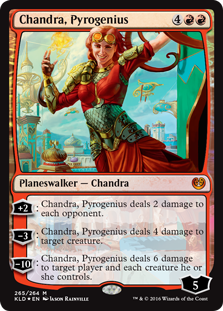
Off to an inauspicious start in both design and naming. Chandra, frankly, was a relief when she was revealed. Folks had been speculating on what would happen if these exclusive planeswalkers were Constructed-playable, and there was a Mind Seize-like run on big box stores. Chandra was a statement of purpose from WotC, saying, effectively, “You won’t need to prioritize picking these up for Standard. Or ever.” In terms of effects, she’s a ten-turn clock, a six-mana removal spell, or a turn-ten one-sided Inferno. Rating: Soporific!
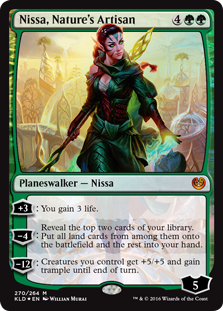
A greenwashed mirror of the Pyrogenius—yes, I do pronounce it erroneously to rhyme with “erogenous”—Nissa’s +3 ability is humorously parsimonious and contrasts with our initial fears of “won’t they run out of effects for planeswalkers?” No, they won’t, so long as they’re willing to go extremely low-rent with the effects. Honestly, I can’t wait for a Tibalt that actively punishes you for his abilities, a true sadistic planeswalker who demands tribute in blood for loyalty. Nissa ramps, she tramps, she gains you three life sometimes. Rating: 3/12
Aether Revolt
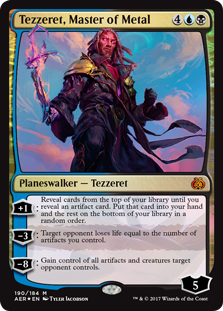
Breaking away from the more generic Kaladesh ‘walkers, Tezzeret gives us both our first multicolored exclusive planeswalker and our first themed one. He’s still pricey at six mana, but slots into a deck that can power him out quickly through mana rocks, if you’re desperate to play him. That first ability is about as low-impact as it gets, and—as the only way to buff him up to that comical ultimate is by using it—isn’t worth the mana. Luckily, he’s in proliferate colors, but there’re better payoffs for your proliferation. Really want to cast this dude off of a pile of Treasure tokens, though, so take that as you set fit. Rating: Incompleat.
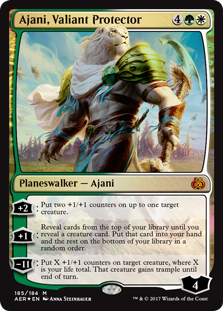
Like Tezz, Ajani’s plus-one ability is a six-mana “draw a card” ability. The initial +2 ability, though, is pretty effective, especially when it targets creatures like Walking Ballista and Hangarback Walker which can convert +1/+1 counters into more than just damage output. The ultimate arrives quickly compared to most of these durdlers, but opens you up to a blowout. Rating: 6/10, but worth a shot in counter-conversion decks.
Amonkhet
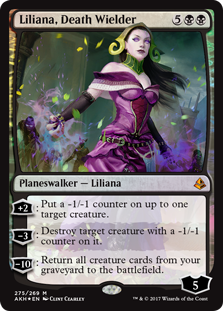
Essentially the test-case for Huatli, Liliana was hyperfocused where other exclusive Planeswalkers were generic. She sticks to the trend of being a mana too pricey and a smidge too low-impact, although I think her specificity helps her. I’ve built two EDH decks since her release (The Scorpion God and Marchesa Prison-Control) that have required her, so clearly there’s a niche for a -1/-1 engine, even a fragile, seven-mana one. Stick to Contagion Engine first, though. Rating: B-
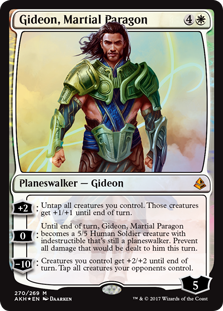
That initial ability is odd, as it decreases the attack potential if you activate it after combat, but wastes the pseudo-vigilance if you activate it second-main. I know it’s designed to play well with Exert, but it comes off as always suboptimal and will be confusing for middle-tier players as they start becoming acclimated to optimal lines of play. Still, he does that Gideon thing of smashing and does so very effectively, and his ultimate is a super-charged Overrun. Rating: Beat+
Hour of Devastation
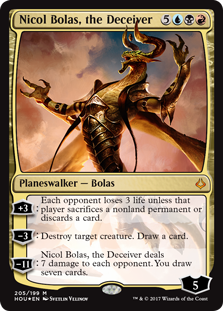
Big and clumsy, the Deceiver is a pretty blunt instrument. Eight mana puts him in mythical territory, but still possible for EDH and slower kitchen table games. Certainly not worth ramping out to, unlike Ugin or Karn, and handicapped by his Grixis color scheme. Still, he’s a Bolas. That +3 is, as all punisher mechanics are, useless unless you’ve completely lapped your opponent, but the -3 is sweet card advantage. The tweaking of the numbers on this—beyond +1, -2/3, -10—is interesting, as it teaches newer players to plan beyond the current turn. Unlike some of the previous planeswalkers (Gideon, Chandra), there’s not as immediate of a choice tied up in the card, and so the upscaled loyalty costs make cost-benefits more opaque. Rating: C-, up to C+ if you’re about the Bolas.
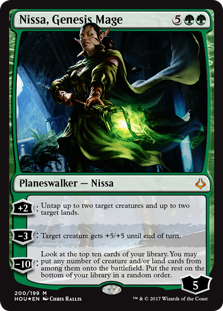
Back to Nissa for the second time in a year. While seven mana is a lot to ask for a terrible Stonewood Invocation, I’ve seen her end games. The +2 ability in the Azusa-style ramp decks is scary, especially when Nissa comes down on turn four or so. Rating: Unseasoned kale.
Ixalan
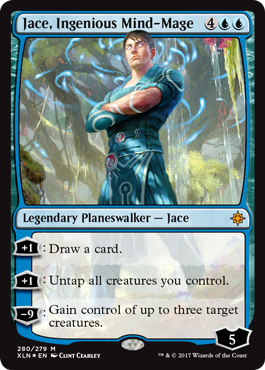
Six-mana, low-impact, color-pie-reinforcing card with a silly name? Welcome back, Pyrogenius. This is not a good card, but you already knew that, so how can we best use it? Personally, I’d throw him in a ramp build—Walking Atlas and such—and then feel incredibly silly for playing a blue ramp deck whose goal is to drop a one-sided Howling Mine. Sure, the ultimate is fun, but you’ll be dead by the time turn eleven rolls around. Rating: Castaway.
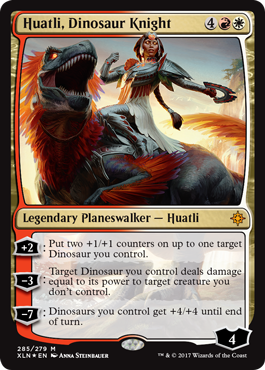
Our very first tribal Planeswalker-deck Planeswalker, Huatli buffs the already-buff and eats the weak. Marginal for actually playing, she seems like a safe bet for collectors—an Aztec-adjacent Dinosaur rider is the sort of nonsense that’s randomly $10 in three years. Rating: Nadir predator.
Summary
So, with two years of Planeswalker decks under our collective belt, what have we learned?

Well, to be frank, we learned that these aren’t for us. “Us” here being defined as “those who consume Magic content and discuss higher-level strategy.” We may pick up Planeswalker decks and jam them with joy, but it’s an act of restriction, rather than of expression, like eating hungover Bojangles or listening to bad chiptunes. There’s pleasure there, but it’s about comfort over quality.
In addition, let’s talk stats for a minute: of the ten exclusive “Planeswalker Deck” planeswalkers printed, only one costs fewer than six mana. That’s such a lazy way to balance card designs—the old shorthand back when I used to pay attention to the card crafting community was that if it’s too good, slap a tax onto the cost—if it’s too weak, it’s now a cantrip.
So more than anything, we—and Wizards—have learned that “niche” is as safe as “overcosted.” Huatli, Tezzeret, and Liliana are expensive, certainly, but the primary function of their design is to fulfill a role in a hyperspecific type of deck (tribal, artifact, “wither matters,” respectively). So far, Wizards has been eager to nail down these planeswalkers in the shared zone of “niche” and “overcosted,” but I’m hoping they’ll lean more into specific archetypes and teach newer players one of the true pleasures of Magic: mapping personality to the game. We’ll talk more about that in a couple weeks—until then, I’m heading to the bunker.
A lifelong resident of the Carolinas and a graduate of the University of North Carolina, Rob has played Magic since he picked a Darkling Stalker up off the soccer field at summer camp. He works for nonprofits as an educational strategies developer and, in his off-hours, enjoys writing fiction, playing games, and exploring new beers.

